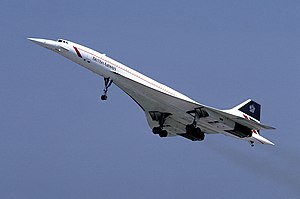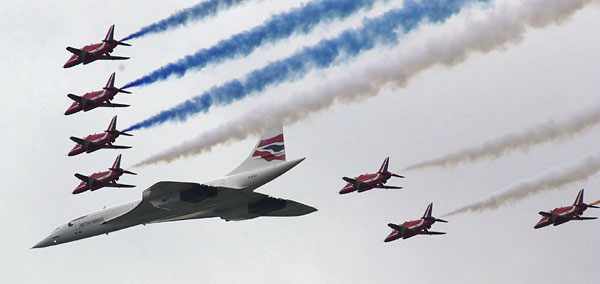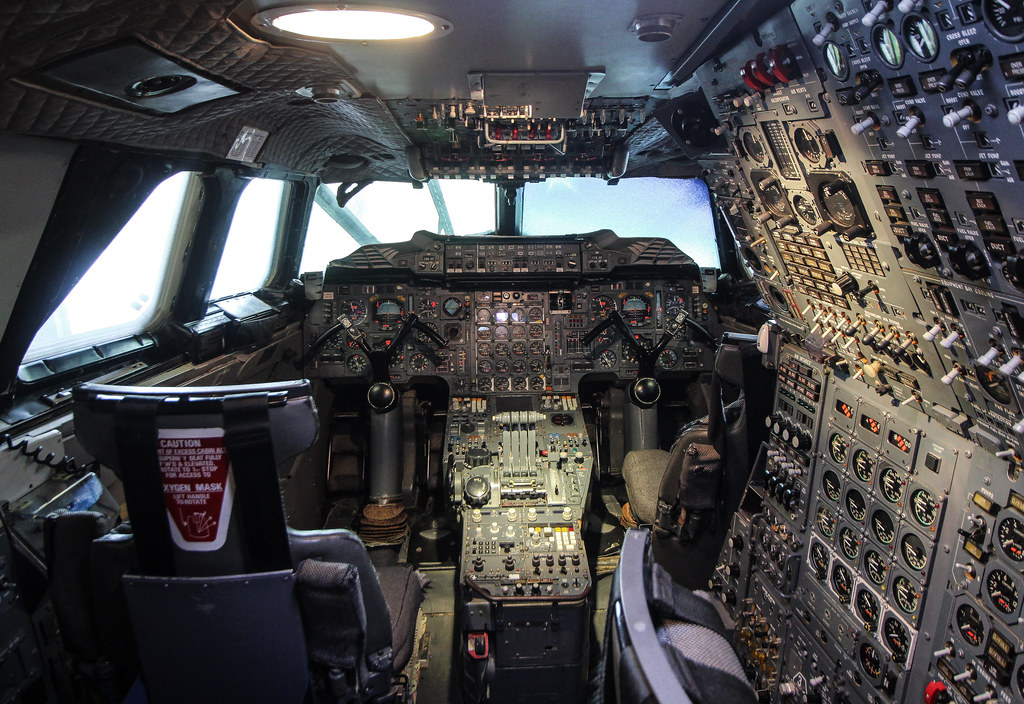The DU Lounge
Related: Culture Forums, Support ForumsOctober 24, 2003: Concorde's last commercial flight.
Yesterday was the anniversary. I knew about it, but other work needed to be done.
I'm posting today, because NOVA on PBS last night was all about the development of the supersonic transport. No doubt this was due to the anniversary.
Season 45 Episode 13 | 53m 41s
NOVA takes you inside the historic international race to develop the first supersonic airliner, the Concorde. Hear stories from those inside the choreographed effort to design and build Concorde in two countries at once—and the crew members who flew her. Then, follow Concorde’s legacy to a new generation of innovators reviving the dream of supersonic passenger travel today.
Aired: 10/09/18 | Expires: 11/21/18 | Rating: TV-G
My father flew on Concorde once. He worked for an airline, and he had a pass. I never flew on it.
I used to work out by Reston, in northern Virginia. Every now and then, a group of us would head out to lunch, and sometimes we would see Concorde flying overhead on the way to or from Dulles.
A lot of good engineering went into Concorde.

British Airways Concorde in 1986
First flight 2 March 1969
Introduction 21 January 1976
Retired 24 October 2003 (1)
Status Retired
The Aérospatiale/BAC Concorde (/ˈkɒnkɔːrd/) is a British-French turbojet-powered supersonic passenger airliner that was operated from 1976 until 2003. It had a maximum speed over twice the speed of sound at Mach 2.04 (1,354 mph or 2,180 km/h at cruise altitude), with seating for 92 to 128 passengers. First flown in 1969, Concorde entered service in 1976 and continued flying for the next 27 years. It is one of only two supersonic transports to have been operated commercially; the other is the Soviet-built Tupolev Tu-144, which operated in passenger service from 1977 to 1978.
Concorde was jointly developed and manufactured by Sud Aviation (later Aérospatiale) and the British Aircraft Corporation (BAC) under an Anglo-French treaty. Twenty aircraft were built, including six prototypes and development aircraft. Air France (AF) and British Airways (BA) were the only airlines to purchase and fly Concorde. The aircraft was used mainly by wealthy passengers who could afford to pay a high price in exchange for the aircraft's speed and luxury service. For example, in 1997, the round-trip ticket price from New York to London was $7,995, more than 30 times the cost of the cheapest option to fly this route.
The original program cost estimate of £70 million met huge overruns and delays, with the program eventually costing £1.3 billion. It was this extreme cost that became the main factor in the production run being much smaller than anticipated. Later, another factor which affected the viability of all supersonic transport programmes was that supersonic flight could only be used on ocean-crossing routes, to prevent sonic boom disturbance over populated areas. With only seven airframes each being operated by the British and French, the per-unit cost was impossible to recoup, so the French and British governments absorbed the development costs. British Airways and Air France were able to operate Concorde at a profit, in spite of very high maintenance costs, because the aircraft was able to sustain a high ticket price.
Among other destinations, Concorde flew regular transatlantic flights from London's Heathrow Airport and Paris's Charles de Gaulle Airport to John F. Kennedy International Airport in New York, Washington Dulles International Airport in Virginia, and Grantley Adams International Airport in Barbados; it flew these routes in less than half the time of other airliners.
Concorde won the 2006 Great British Design Quest organised by the BBC and the Design Museum, beating other well-known designs such as the BMC Mini, the miniskirt, the Jaguar E-Type, the London Tube map and the Supermarine Spitfire. The type was retired in 2003, three years after the crash of Air France Flight 4590, in which all passengers and crew were killed. The general downturn in the commercial aviation industry after the September 11 attacks in 2001 and the end of maintenance support for Concorde by Airbus (the successor company of both Aérospatiale and BAC) also contributed.
....
Retirement
On 10 April 2003, Air France and British Airways simultaneously announced they would retire Concorde later that year. They cited low passenger numbers following the 25 July 2000 crash, the slump in air travel following the September 11 attacks, and rising maintenance costs. Although Concorde was technologically advanced when introduced in the 1970s, 30 years later, its analogue cockpit was outdated. There had been little commercial pressure to upgrade Concorde due to a lack of competing aircraft, unlike other airliners of the same era such as the Boeing 747. By its retirement, it was the last aircraft in the British Airways fleet that had a flight engineer; other aircraft, such as the modernised 747-400, had eliminated the role.
On 11 April 2003, Virgin Atlantic founder Sir Richard Branson announced that the company was interested in purchasing British Airways' Concorde fleet "for the same price that they were given them for – one pound". British Airways dismissed the idea, prompting Virgin to increase their offer to £1 million each. Branson claimed that when BA was privatised, a clause in the agreement required them to allow another British airline to operate Concorde if BA ceased to do so, but the Government denied the existence of such a clause. In October 2003, Branson wrote in The Economist that his final offer was "over £5 million" and that he had intended to operate the fleet "for many years to come". The chances for keeping Concorde in service were stifled by Airbus's lack of support for continued maintenance.
....
Air France
Air France made its final commercial Concorde landing in the United States in New York City from Paris on 30 May 2003. Air France's final Concorde flight took place on 27 June 2003 when F-BVFC retired to Toulouse.
....
British Airways
British Airways conducted a North American farewell tour in October 2003. G-BOAG visited Toronto Pearson International Airport on 1 October, after which it flew to New York's John F. Kennedy International Airport. G-BOAD visited Boston's Logan International Airport on 8 October, and G-BOAG visited Washington Dulles International Airport on 14 October.
In a week of farewell flights around the United Kingdom, Concorde visited Birmingham on 20 October, Belfast on 21 October, Manchester on 22 October, Cardiff on 23 October, and Edinburgh on 24 October. Each day the aircraft made a return flight out and back into Heathrow to the cities, often overflying them at low altitude. On 22 October, both Concorde flight BA9021C, a special from Manchester, and BA002 from New York landed simultaneously on both of Heathrow's runways. On 23 October 2003, the Queen consented to the illumination of Windsor Castle, an honour reserved for state events and visiting dignitaries, as Concorde's last west-bound commercial flight departed London.
British Airways retired its Concorde fleet on 24 October 2003. (1) G-BOAG left New York to a fanfare similar to that given for Air France's F-BTSD, while two more made round trips, G-BOAF over the Bay of Biscay, carrying VIP guests including former Concorde pilots, and G-BOAE to Edinburgh. The three aircraft then circled over London, having received special permission to fly at low altitude, before landing in sequence at Heathrow. The captain of the New York to London flight was Mike Bannister. The final flight of a Concorde in the US occurred on 5 November 2003 when G-BOAG flew from New York's JFK Airport to Seattle's Boeing Field to join the Museum of Flight's permanent collection. The plane was piloted by Mike Bannister and Les Broadie, who claimed a flight time of three hours, 55 minutes and 12 seconds, a record between the two cities. The museum had been pursuing a Concorde for their collection since 1984. The final flight of a Concorde worldwide took place on 26 November 2003 with a landing at Filton, Bristol, UK.
....

Parade flight at Queen's Golden Jubilee in June 2002
....
Citations
(1) Lawless, Jill (26 October 2003). "Final Concorde flight lands at Heathrow". Washington Post. Associated Press.
....
lapfog_1
(29,205 posts)It had a lot of issues, chiefly was the per passenger fuel consumption.... the worst in commercial aviation.
Not being allowed to fly supersonic over the US meant that the routes were pretty restricted.
All of this meant that ticket prices were high... so high as to make it out of the reach of the typical airline passenger.
Add to that the one fatal crash because of runway incursion... and the bloom was off the rose of supersonic passenger travel.
Still, I worked on the US replacement ( the "Space Plane" ) for a number of years while at NASA. Almost sorry that the program "went black" and commercial worked stopped on the concept by the late 1990s. Of course, there is the rumored "Aurora" project which may or may not be a reality.
https://www.nasa.gov/langley/feature/setting-the-spaceplane-stage
https://www.disclose.tv/project-aurora-lockheed-martin-just-confirmed-theyre-building-the-sr-72-315211
DemoTex
(25,399 posts)Paris CDG to New York JFK. I spent about an hour of the flight visiting the flight deck, at the invitation of the captain.

mahatmakanejeeves
(57,490 posts)SeattleVet
(5,477 posts)It was scheduled to come in at something like 3:00, so we decided to go way early to get a good spot by the fence at the Museum of Flight to watch it come in. Glad we got there early, since the aircraft ALSO got there about 40 minutes early, setting the JFK to Seattle record in the process. They had received permission from Canada to fly supersonic over their territory. I saw it coming in with Mount Rainier in the background, and a short time later it landed right in front of us, then was towed (after some trouble with a broken towbar) to a temporary spot on the Museum grounds. It now sits proudly in the Pavillion, along with the first 747, JFK's Air Force One, and several other historical artifacts.
When the plane was flying at supersonic speed, it would expand. When it expanded, gaps opened up between the panels on the flight deck. The flight engineer removed his hat and stuck the edge of it between the panels before they started their descent, and the hat was permanently wedged between the panels. Unfortunately, some yahoo decided to cut it off and take it as a souvenir, which almost caused British Airways to take the plane back. The hat was returned and restored. Also, as the crew and VIP guests exited the aircraft after landing they all signed the frame of the doorway in Sharpie. You can see all of the signatures if you walk through the Concorde at the Museum.